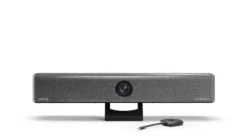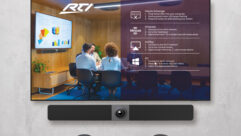THE CONNECTED CONFERENCE ROOM
Dec 1, 2002 12:00 PM,
JAMES DIAS
During the past decade, corporations have spent millions of dollars equipping their meeting rooms, conference rooms, and training facilities with sophisticated recording devices, screens, projectors, and so on. The end result is a rich communication environment, but only the people sitting in the room can experience it. With today’s emphasis on timely information and an increasingly distributed and mobile workforce, extending and capturing the communications that occur in those rooms — and making them available through the Internet to anyone at anytime — is critical.
Enter Web communications. Contractors looking to create new revenue from their customer installations should take a look at a new generation of turnkey systems that transform these spaces into Web-connected facilities.
Web communications — e-learning, online training, and online corporate communications applications — have risen dramatically during the past 15 months.
Research firm Gartner estimates that by 2005, the e-learning market will reach $33.6 billion in sales, up from $2.1 billion in 2001. That growth stems from a steady increase in demand from education, government, and business.
In an August 2002 survey by Wainhouse Research, more than 70 percent of the 703 respondents said they are interested in communication alternatives to travel. Additionally, more than two-thirds of those surveyed believe using audio, Web, and videoconferencing would allow them to be more productive, help them make faster decisions, and give them more free time.
A recent survey of 600 major companies conducted by research firm www.brandon-hall.com found that 60 percent now offer online training as a component to their overall training programs, a 12 percent increase from the year before.
The cause of the increase in the acceptance and use of business conferencing and Webcasting is commonly attributed to a number of factors, including travel costs and concerns, a dispersed target audience, and the need to communicate with speed and convenience. Although those factors have played a role in the growing trend, an often overlooked contributor is the technology itself.
Once financially and technically prohibitive, the latest generations of Web communication solutions have torn down many of the barriers to their adoption. A whole class of technologies has matured enough to deliver dramatic improvements in quality, productivity, and cost reduction, which companies can quickly see. The technology has made tremendous improvements for the user experience, eliminating the frustrations of early Internet content creation and viewing, and some systems have become surprisingly easy to use in everyday communications.
Organizations are not willing to look at total cost of ownership issues until the complexity issue is out of the way. That is where we are now. The industry has begun to focus on specific applications that are meaningful for customers. As a result, expect a mainstreaming of those technologies in 2003-04 as more vendors concentrate their efforts on developing businesscentric products that address business processes and are easy to install, easy to use, and largely automated.
WEB MEETINGS
Many of the Web communication systems of today can be considered offspring to videoconferencing systems. Federal, state, and local governments, along with the corporate and education sectors, have invested heavily in videoconferencing tools and infrastructure to support a variety of their remote communications requirements. Although the systems have been used for everything from meetings to interviews to distance learning, in terms of widespread market adoption, it seems videoconferencing has never lived up to the hype.
That is because videoconferencing is largely a point-to-point technology encumbered by premise equipment and, until recently, specific telecommunications requirements such as ISDN. By and large, you have to go to a specific room designed and equipped in a particular way to participate effectively. Furthermore, it’s relatively expensive and difficult to capture and archive the proceedings to make them available for access on demand. As a result, highly mobile people — telecommuters, salespeople, and field service reps — have to take great pains to participate or miss the event entirely. Today’s workforce increasingly expects rapid and convenient access to timely and portable information, and videoconferencing’s largely facility-centric model typically doesn’t meet its needs.
Web communication systems, on the other hand, take advantage of the ubiquitous IP communications protocol and let users partake in corporate communications regardless of location. A PC, a browser, and an Internet connection are all that is needed. The field is effectively broken down into two application groups, each optimized for the mode of communication.
The first, Web conferencing, centers on collaboration and offers users the benefits of using Web infrastructure for online meetings that require a high degree of interactivity, such as brainstorming and planning. The second, Web presentations, focuses on content, providing users the economic benefits of Internet distribution for the purposes of training, product marketing, and other rich content distribution applications. Web presentation systems trade off some of the low-latency human interactivity capabilities to offer a significantly lower cost per person, allowing companies to reach a much wider audience, both live and on demand at a fraction of the price.
SOLUTIONS
The transparency level is another key difference between traditional videoconferencing and more recent Web communication solutions. Some vendors, having studied the communications environment in corporations and education institutions, understand how processes and users in these organizations operate. Their products and services are designed specifically to address and fit into those processes without disruption or requiring the process to be adapted to benefit from the technology.
From a contractor’s point of view, what is needed are Web communication systems that don’t require room modifications and, in fact, revitalize the investments companies initially made in conference and training facilities. By simply adding a capture workstation into one of those rooms, companies will gain the ability to automatically capture, encode, and deliver presentations in real time for use on the Web.
These real-time automated systems, which can be easily incorporated into the existing meeting room or presentation facility, represent a dramatic improvement over the existing alternatives available just a year ago. For most companies that opted to use Web communications, it was a labor-intensive and expensive process that required the skills of audio/video technicians to make a prerecorded presentation Web ready.
By contrast, some systems now remove this production and postprocessing work for synchronizing video, audio, and collateral material and instead automate the process. That lets presenters and instructors focus on creating and giving their presentations while the system automatically and transparently captures, streams, and indexes the rich media content.
SELECTING A SYSTEM
There certainly is no shortage of companies clamoring for your Web communications business. Wading through the choices can be as mind-boggling to customers as selecting a mobile phone and calling plan. But like anything else, when evaluating these tools, it’s important to know what features will make the difference in a successful solution.
Make sure the system is designed with presenters in mind, not technicians or production operators. The newer technologies should stay in the background and not be invasive to the presenter or the landscape of the room. The system should be easy to set up and use, without any special preparation, costly production, or complex authoring required. Look for integrated systems (hardware and software) that address the specific workflow associated with business and educational presentations.
The type of equipment in rooms varies. For example, a training room probably will have smart boards and document cameras, whereas a conference room most likely will not. It’s important that the system you choose is able to capture and stream content from any type of device. You don’t want to limit presenters solely to PowerPoint slides.
The product should be able to work in a variety of applications so that it can be easily integrated with full in-house training systems or other large-scale audio/video production equipment. The solution should have broad appeal to a variety of nontechnical users so that it gets maximum use. This provides a rapid return on investment and lowers the cost of ownership. Look for offerings that keep license agreements simple — that is where costs usually creep back in.
Whether building new, Web-enabled presentation rooms or adding that functionality to existing ones, the Web communications market for sound and video contractors should continue to grow during the years to come. More and more companies want the communications and content from their presentation facilities to be accessible over the Internet to keep pace with worker and customer expectations for convenient, high-quality, and timely information.
James Dias is the vice president of strategic solutions and alliances for Sonic Foundry.










